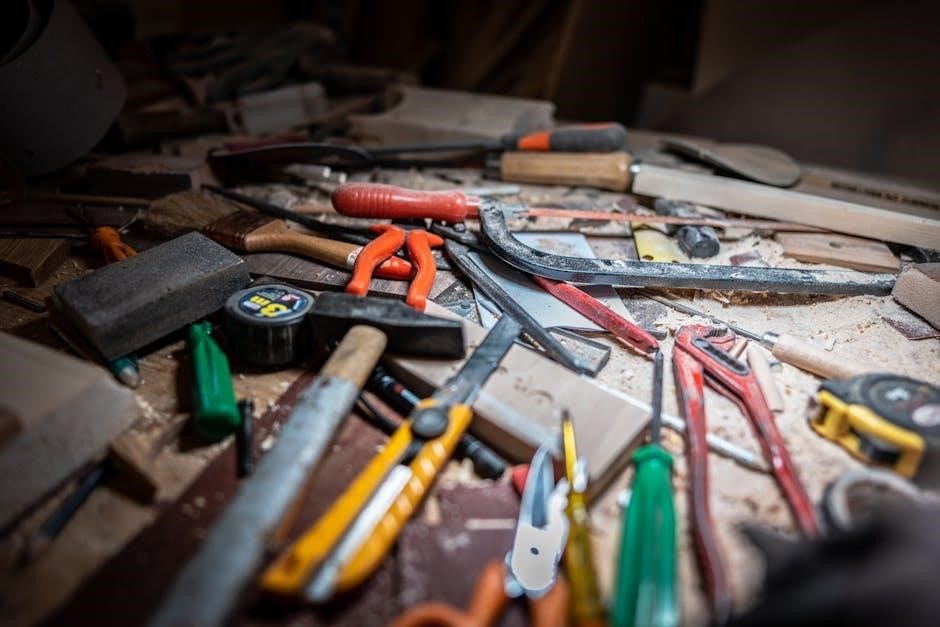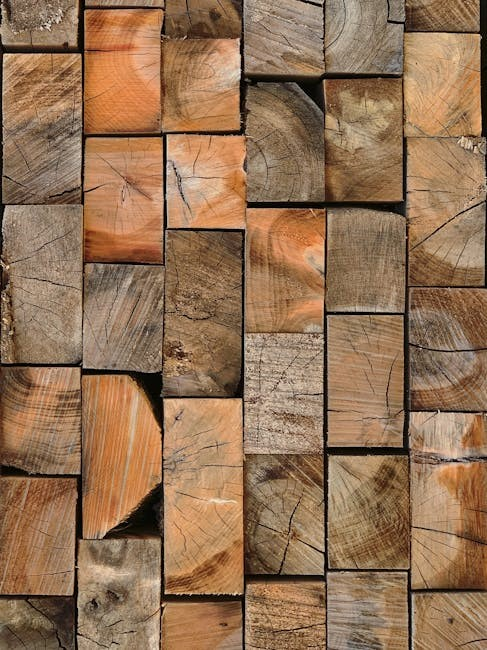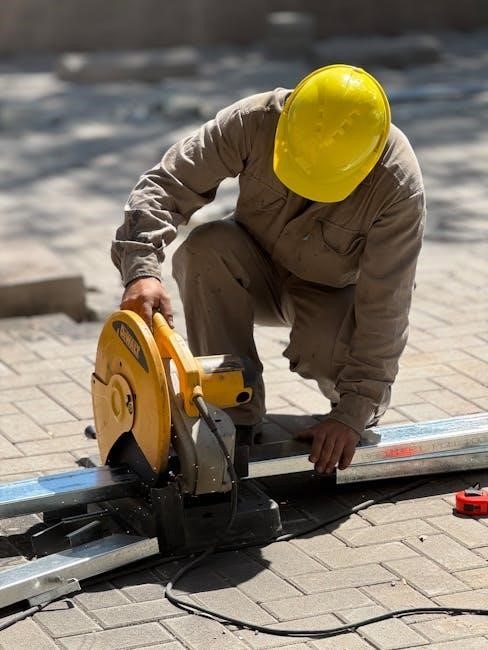A reciprocating saw guide block is a critical component that enhances cutting precision and stability. It ensures smooth blade movement, reducing vibration and improving overall performance in various applications.
1.1 Definition and Purpose
A reciprocating saw guide block is a mechanical component designed to stabilize and align the saw blade, ensuring precise cuts. Its primary purpose is to maintain blade stability, reducing vibration and improving accuracy. By guiding the blade’s movement, it enhances control during cutting operations, making it essential for achieving clean and consistent results in various materials like wood, metal, and plastic. This component is crucial for optimizing the performance of reciprocating saws in both professional and DIY applications.
1.2 Importance in Reciprocating Saws
The guide block plays a vital role in enhancing the performance and accuracy of reciprocating saws. It minimizes blade deflection and vibration, ensuring straighter cuts and better control. By maintaining proper blade alignment, it reduces wear on the saw and extends blade life. This component is essential for precise cutting in various materials, making it a key factor in achieving professional-grade results. Its importance lies in its ability to improve efficiency, reduce waste, and deliver consistent performance across different applications.
1.3 Key Components of the Guide Block
The guide block consists of a robust housing, precision-engineered to hold the blade in alignment. It includes a sliding mechanism that allows for smooth blade movement and a locking system to secure the blade in place. High-quality materials ensure durability and resistance to wear. The block’s design incorporates features that dampen vibration and noise, enhancing user comfort and cutting efficiency. These components work together to maintain accuracy and consistency, making the guide block indispensable for optimal saw performance.

Materials and Manufacturing Process
Durable materials like steel or aluminum are used for the guide block, ensuring strength and longevity. Advanced manufacturing techniques, including CNC machining, guarantee precise and reliable construction.
2.1 Types of Materials Used
The guide block is typically made from high-quality steel or aluminum, ensuring durability and resistance to wear. These materials are chosen for their strength and ability to withstand heavy use, making them ideal for both professional and DIY applications. Additionally, some premium models may incorporate advanced alloys or hardened coatings to enhance performance and extend lifespan. The choice of material directly impacts the guide block’s reliability and precision, ensuring consistent results across various cutting tasks.
2.2 Manufacturing Techniques
The manufacturing process involves CNC machining for precision and consistency. High-accuracy grinding ensures smooth surfaces, while heat treatment enhances durability. Advanced techniques like laser cutting are used for complex geometries, and robotic assembly ensures tight tolerances. Quality control measures, such as dimensional inspections, guarantee reliability. These methods collectively ensure the guide block’s performance, longevity, and compatibility with various reciprocating saw models.
2.3 Quality Control Measures
Quality control involves rigorous testing to ensure durability and precision. Guide blocks undergo dimensional inspections to verify accuracy. Material integrity is checked through hardness and wear tests. Advanced techniques like laser alignment ensure proper fitment. Each component is inspected for surface finish and structural integrity. These measures guarantee consistent performance and longevity, ensuring the guide block meets industry standards for reliability and functionality in various applications.

Types of Reciprocating Saw Guide Blocks
Guide blocks vary by design, offering standard, adjustable, and custom options. Each type caters to specific needs, ensuring optimal performance across different cutting tasks and materials.
3.1 Standard Guide Blocks
Standard guide blocks are the most common type, designed for general-purpose use. They are typically made from durable materials like steel or aluminum, ensuring longevity and reliability. These blocks are pre-sized to fit specific blade widths, offering consistent performance for routine cutting tasks. Ideal for straight cuts, they are widely used in construction, woodworking, and metalworking. Their simplicity and compatibility with most reciprocating saws make them a popular choice for professionals and DIYers alike. Standard guide blocks are cost-effective and provide dependable results in various applications.
3;2 Adjustable Guide Blocks
Adjustable guide blocks offer flexibility and precision by allowing users to customize the blade alignment and tension. This feature is particularly useful for intricate cuts or when working with different blade types and materials. With adjustable blocks, professionals can achieve higher accuracy and reduce wear on the saw and blade. They are ideal for applications where versatility is key, such as metalworking, woodworking, and demolition. The ability to fine-tune settings ensures optimal performance, making adjustable guide blocks a valuable asset for demanding projects and varied tasks.
3.4 Custom-Made Guide Blocks
Custom-made guide blocks are tailored to meet specific user requirements, offering superior performance for unique applications. Designed with particular materials and dimensions, they cater to specialized tasks, such as cutting thick metals or precise plastics. These blocks often feature enhanced durability and are crafted to fit specific saw models, ensuring seamless integration. Their bespoke nature allows for optimized blade alignment and reduced vibration, making them ideal for professionals seeking precise control and extended tool longevity in challenging environments.

Installation and Maintenance
Proper installation involves aligning the guide block accurately and securing it firmly. Regular maintenance includes cleaning and lubricating moving parts to ensure smooth operation and longevity.
4.1 Step-by-Step Installation Guide
Ensure the reciprocating saw is turned off and unplugged for safety. Align the guide block with the saw’s shoe or base, securing it firmly. Tighten all screws evenly to maintain balance. Double-check alignment to avoid uneven cuts. Test the saw on scrap material to confirm accuracy. Regularly clean and lubricate the guide block to ensure smooth operation. Replace worn-out parts promptly to maintain performance.
4.2 Maintenance Tips for Longevity
Regularly inspect the guide block for wear and tear, replacing damaged parts immediately. Clean the block with a soft cloth and mild detergent to prevent debris buildup. Apply a light layer of machine oil to moving parts to reduce friction. Store the saw in a dry, cool place to avoid rust. Avoid using harsh chemicals that could degrade materials. Schedule professional maintenance annually for optimal performance and extend the guide block’s lifespan.
4.3 Common Installation Mistakes
One common mistake is misaligning the guide block with the blade, leading to inaccurate cuts. Over-tightening the block can damage the saw or restrict blade movement. Using incorrect tools for installation may result in improper fitting. Forgetting to check compatibility with the saw and blade type is another oversight. Additionally, neglecting to secure the block firmly can cause vibration and reduced precision. Always follow the manufacturer’s instructions and double-check alignment before use to ensure optimal performance and avoid costly repairs.


Factors Influencing Performance
Blade compatibility, motor power, and user technique significantly impact performance. Proper alignment and guide block quality also play crucial roles in achieving precise and efficient cutting results.
5.1 Blade Compatibility
Blade compatibility is crucial for optimal performance. Using the correct blade type ensures efficient cutting and reduces wear on the guide block. Different materials require specific blades, such as wood or metal-cutting designs. Compatibility also affects the saw’s stability and accuracy. Proper blade alignment with the guide block prevents misalignment and extends tool longevity. Always choose blades designed for your saw’s specifications to maintain performance and safety. Improper blades can lead to poor results and potential damage to the saw or guide block.
5.2 Motor Power and Speed
Motor power and speed significantly influence the performance of a reciprocating saw. Higher power motors handle demanding tasks more efficiently, reducing strain on the guide block. Variable speed settings allow for better control, enabling precise cuts in diverse materials. Consistent power delivery ensures stability and accuracy, minimizing wear on the guide block. However, excessive power can lead to reduced control and potential damage to the tool or workpiece, making it essential to choose the right balance for optimal results.
5.3 User Technique and Experience
User technique and experience play a crucial role in maximizing the efficiency of a reciprocating saw guide block. Proper handling, including consistent pressure and alignment, ensures accurate cuts and reduces wear. Experienced users can better utilize the guide block’s features, such as maintaining straight cuts and handling various materials effectively. Training and practice enhance control, leading to improved results and equipment longevity. Mastery of these skills optimizes the guide block’s performance, making it an indispensable tool for professionals and DIYers alike.

Choosing the Right Guide Block
Selecting the right guide block involves considering factors like compatibility, material quality, and specific application needs to ensure optimal performance and durability for your reciprocating saw.
6.1 Performance Features to Consider
When selecting a guide block, prioritize features like durability, alignment accuracy, and vibration resistance. High-quality materials ensure longevity, while precise alignment enhances cutting accuracy. Anti-vibration designs reduce fatigue and improve control, making intricate cuts easier. Additionally, consider the ease of installation and compatibility with various blade types. Advanced models may offer adjustable settings for customized performance. Evaluating these features ensures the guide block meets your specific needs, optimizing both efficiency and results in different applications.
6.2 Compatibility with Your Saw
Ensuring the guide block is compatible with your reciprocating saw is essential for optimal performance. Different saw models and brands may require specific guide block designs. For instance, Milwaukee and DeWalt saws often have unique mounting systems, while Ryobi and Bosch may need adapters. Always check the manufacturer’s specifications to confirm compatibility. A properly fitted guide block ensures accurate blade alignment and reduces vibration. Incompatible setups can lead to misalignment and inefficient cutting. Prioritize guide blocks designed for your saw’s make and model to maintain precision and extend tool longevity.
6.3 Budget and Cost-Effectiveness
When selecting a reciprocating saw guide block, budget plays a crucial role. High-end models offer advanced features and durability but may exceed certain budgets. Mid-range options provide a balance of quality and affordability, while budget-friendly alternatives can meet basic needs. Consider longevity and performance when evaluating costs. Cheaper options might require frequent replacements, increasing long-term expenses. Investing in a durable guide block can enhance tool efficiency and reduce maintenance costs over time, making it a cost-effective choice for frequent users.

Applications in Different Industries
Reciprocating saw guide blocks are essential in construction, metalworking, plumbing, and landscaping. They enable precise cuts in wood, metal, and PVC, enhancing efficiency across various industrial tasks.
7.1 Construction and Carpentry
In construction and carpentry, reciprocating saw guide blocks are indispensable for making precise cuts in wood and PVC. They enhance accuracy during framing, demolishing, and trimming tasks. The guide block’s stability ensures straight cuts, reducing material waste and improving finish quality. Carpenters rely on these components for efficient workflow, especially in tight spaces where control is crucial. Their durability and compatibility with various blades make them a must-have tool for professionals aiming for clean, professional results in woodworking projects.
7.2 Metalworking and Fabrication
In metalworking and fabrication, reciprocating saw guide blocks play a vital role in cutting through tough materials like steel and aluminum. They provide the precision needed for intricate cuts, minimizing vibrations and ensuring clean finishes. Professionals rely on these components for tasks such as cutting pipes, angle irons, and thin metal sheets. The guide block’s durability and compatibility with specialized blades make it an essential tool for achieving accurate results in demanding industrial environments, enhancing both safety and efficiency in metal fabrication processes.
7.3 Plumbing and HVAC
In plumbing and HVAC, reciprocating saw guide blocks are indispensable for cutting pipes, ductwork, and structural materials. They allow for precise, clean cuts in tight spaces, reducing the risk of damage to surrounding components. Plumbers and HVAC technicians rely on these guide blocks to maintain accuracy and efficiency when working with PVC, copper, and metal pipes. The stability provided by the guide block ensures smooth operation, making it a crucial tool for professionals needing to navigate complex systems and materials in confined work environments.
7.4 Landscaping and Gardening
In landscaping and gardening, reciprocating saw guide blocks are essential for pruning thick branches and cutting through tough vegetation. The guide block ensures precise control, enabling gardeners to make clean cuts without damaging nearby plants. It is particularly useful for trimming tree branches, shrubs, and roots. The stability and accuracy provided by the guide block make it an ideal tool for maintaining neat and healthy outdoor spaces, allowing professionals and hobbyists alike to achieve professional-grade results with minimal effort and time.

Common Issues and Solutions
Common issues include misalignment, wear, and noise. Regular maintenance, alignment checks, and replacing worn parts can resolve these problems, ensuring optimal performance and longevity of the guide block.
8.1 Misalignment and Accuracy Problems
Misalignment and accuracy issues often arise from improper installation or wear of the guide block. Symptoms include uneven cuts and reduced precision. To resolve this, ensure the guide block is properly aligned with the blade and tightened securely. Regularly inspect for wear and replace damaged components. Using compatible blades and maintaining proper tool calibration can also improve accuracy. Addressing these issues promptly prevents further damage and ensures consistent performance in cutting tasks. Proper maintenance and alignment checks are essential for optimal functionality.
8.2 Wear and Tear Over Time
Wear and tear on the guide block can lead to reduced performance and accuracy. Prolonged use causes friction and heat, which degrade the material. Inspect the block regularly for signs of wear, such as scoring or uneven surfaces. Replace it immediately if damage is detected to prevent blade misalignment. Using high-quality materials and proper maintenance can extend its lifespan. Regular lubrication and cleaning also help mitigate wear. Addressing wear early ensures consistent tool performance and avoids costly repairs down the line.
8.3 Noise and Vibration Issues
Noise and vibration issues in reciprocating saws often stem from misaligned or worn guide blocks. Loose or improperly fitted blocks can cause the blade to wobble, leading to increased noise and reduced control. Regular lubrication and proper alignment are essential to minimize vibration. Additionally, using compatible blades and maintaining the guide block’s condition can significantly reduce operational noise. Addressing these issues ensures smoother operation, better accuracy, and a more comfortable user experience, making it crucial to inspect and maintain the guide block regularly.

Market Trends and Future Developments
The market is shifting toward smart tool integration and eco-friendly materials. Advances in guide block technology focus on enhancing durability and precision, driven by user demand for superior performance.
9.1 Advances in Material Technology
Recent advancements in material technology have led to the development of lightweight, high-durability guide blocks. Carbon fiber and advanced alloys are now commonly used, offering superior strength-to-weight ratios. Self-lubricating materials reduce friction, enhancing blade performance and extending tool lifespan. Additionally, eco-friendly materials are gaining traction, aligning with sustainability trends. These innovations ensure guide blocks are more efficient, reliable, and adaptable to various industrial applications, meeting the evolving demands of modern reciprocating saw users.
9.2 Integration with Smart Tools
The integration of reciprocating saw guide blocks with smart tools is revolutionizing the industry. Modern guide blocks now feature sensors and IoT connectivity, enabling real-time performance monitoring. Bluetooth integration allows users to adjust settings via smartphone apps, optimizing blade alignment and reducing vibration. This technology enhances precision and efficiency, particularly in industrial settings. Additionally, data collected from these tools aids in predictive maintenance, minimizing downtime. As smart tools become more prevalent, the guide block’s role in enhancing functionality and user experience continues to expand, setting new standards for innovation in power tools.
9.3 Growing Demand for Cordless Saws
The growing demand for cordless saws is reshaping the power tool industry, with reciprocating saws at the forefront. Users value the portability and convenience of cordless options, driving manufacturers to enhance guide block designs for optimal performance. Advanced 18V and brushless motor systems improve efficiency and runtime, making cordless saws indispensable for professionals. Guide blocks are now engineered to support these systems, ensuring smooth operation and extended tool longevity. This trend is accelerating innovation, with brands like Milwaukee and DeWalt leading the charge, making cordless technology a standard in modern reciprocating saws.
